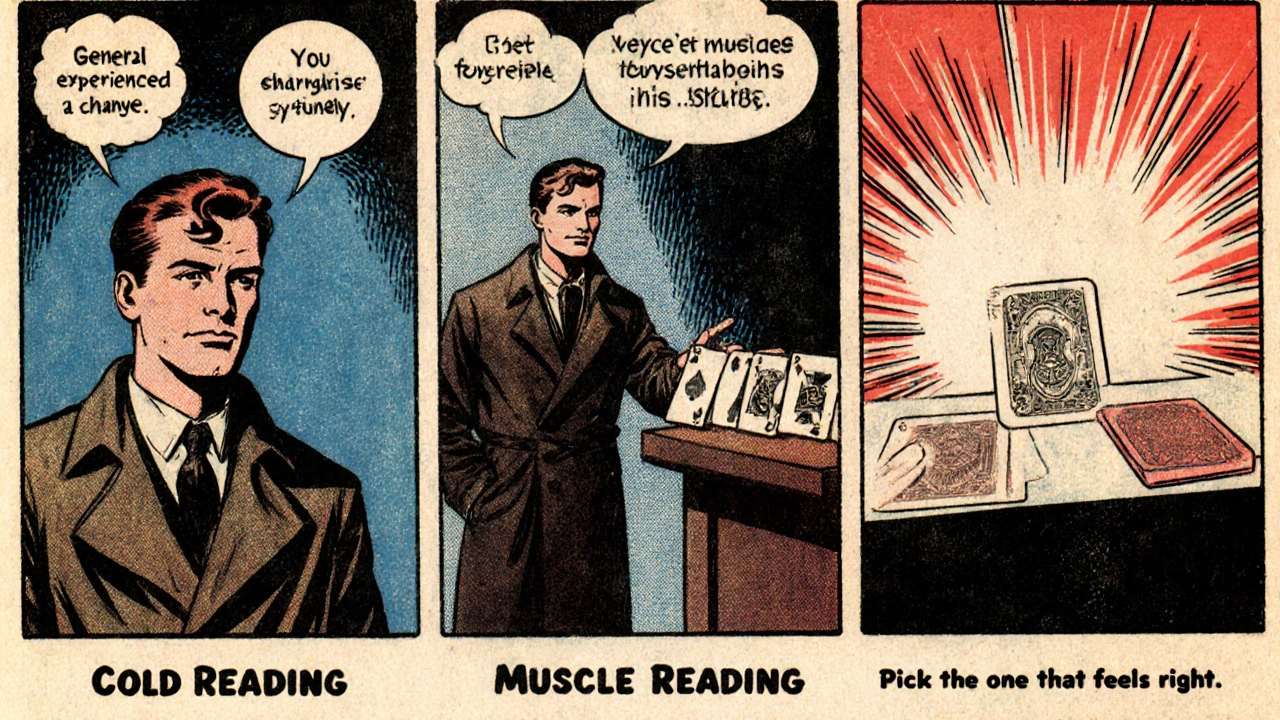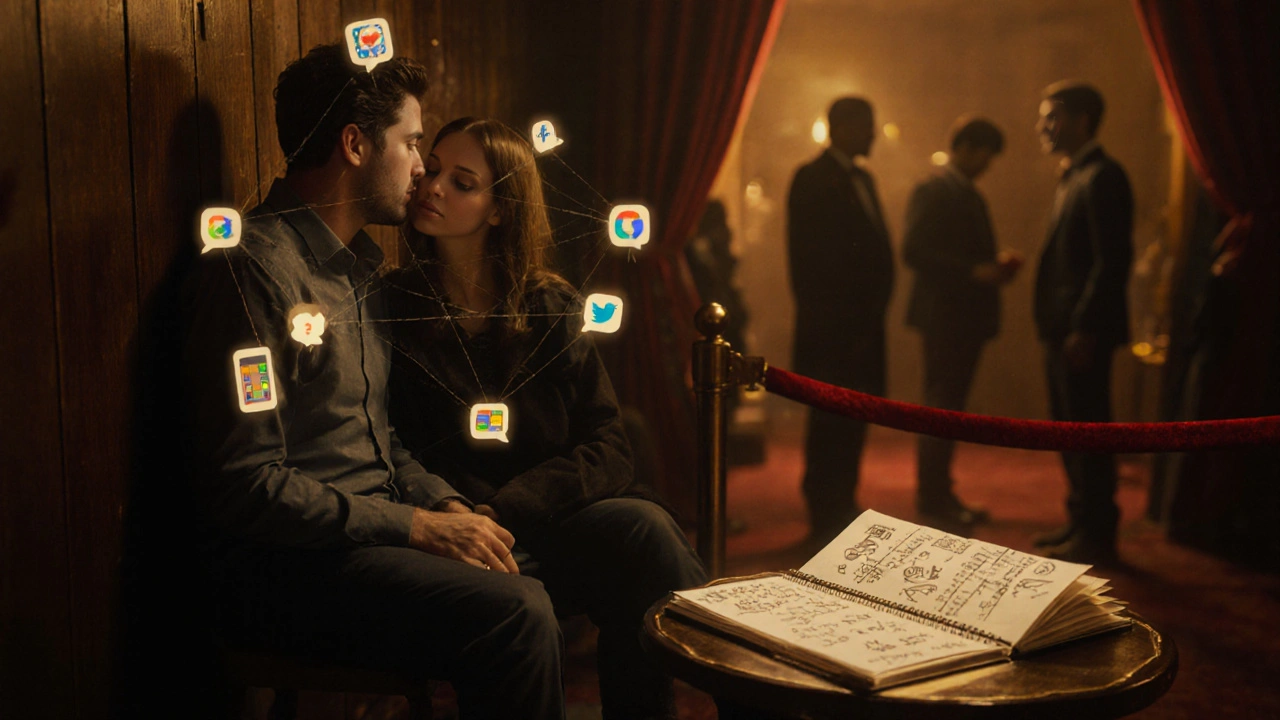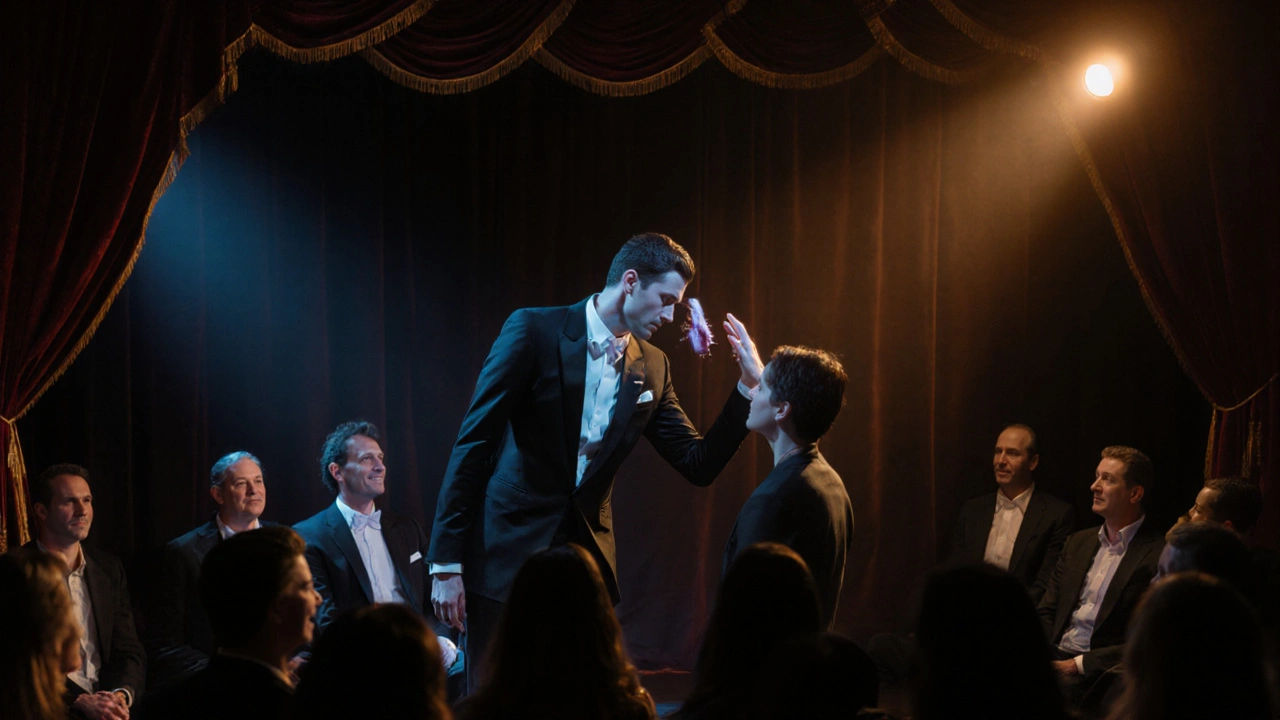Psychological Forcing Calculator
How Psychological Forcing Works
Psychological forcing manipulates choices by subtly guiding participants toward a predetermined outcome. This tool calculates the probability of success based on forcing technique, participant confidence, and number of choices.
Results will appear here after calculation
Ever watched a performer seemingly pull a random word straight out of your head and wondered how they did it? The answer isn’t telepathy - it’s a carefully crafted mind reading trick that blends psychology, observation, and a dash of showmanship.
Key Takeaways
- Mind‑reading tricks rely on subtle cues, suggestion, and pre‑show preparation.
- Three core techniques dominate: cold reading, muscle reading, and psychological forcing.
- Mastering patter, timing, and audience management turns a simple effect into a baffling experience.
- Practice with real people, not just mirrors, to sharpen your perception skills.
- Avoid common pitfalls like over‑explaining or exposing the method.
What a Mind‑Reading Trick Actually Is
Mind-Reading Trick is a mentalism effect that creates the illusion of reading someone's thoughts. The performer appears to know a piece of private information - a number, a word, or a feeling - without any overt communication. In reality, the trick exploits predictable human behavior and well‑rehearsed structures.
Core Techniques Behind the Effect
While every mentalist adds their own flair, three methods form the backbone of most mind‑reading effects.
1. Cold Reading
Cold Reading is a set of observational and verbal techniques used to give the impression of knowing personal details about someone. The performer watches body language, facial micro‑expressions, and verbal cues, then makes high‑probability statements that feel personal.
Typical steps include:
- Start with broad statements ("You’ve had a recent change in your life.") that apply to most people.
- Observe the audience’s reaction - a nod, a smile, or a frown.
- Zoom in with more specific details based on that reaction.
This method works because our brains love to fill gaps with our own story, making vague hints seem spot‑on.
2. Muscle Reading (Ideomotor Effect)
Muscle Reading is a technique that detects unconscious muscular responses to guide the performer to a hidden choice. The subject holds a small object, and the mentalist subtly moves around while feeling the slightest tension in the subject’s muscles, which shift toward the correct answer.
Key ingredients:
- Gentle touching or “holding hands” to maintain a physical connection.
- Slow, deliberate movement so the performer can sense tiny changes.
- Practice in a quiet environment to isolate the micro‑muscle signals.
Classic examples include finding a hidden playing card or locating a secret word in a notebook.
3. Psychological Forcing
Psychological Forcing is a method of subtly influencing a participant to select a predetermined option without them realizing it. By controlling language, visual cues, and timing, the performer narrows the audience’s choices.
Common forcing patterns:
- Word‑choice forcing - embedding the target word in a sentence that feels natural.
- Visual forcing - arranging cards or objects so the eye is drawn to the desired item.
- Verbal anchoring - using a phrase like “think of something that feels warm” to bias thoughts.
When executed smoothly, the spectator believes they made a free choice.

Supporting Elements That Make the Trick Convincing
Pre‑Show Work
Pre-show Work is the backstage preparation where the mentalist gathers information about the audience before the performance. This can be as simple as chatting with a few attendees, reading social media posts, or using a hidden questionnaire.
Even a single piece of personal data - a favorite color or a recent trip - can be woven into the routine, creating a wow moment that feels like genuine mind‑reading.
Dual Reality
Dual Reality is a performance strategy where the audience and a participant experience two different versions of the effect simultaneously. The performer may appear to read the participant’s mind while the participant believes they are simply following instructions.
This technique protects the secret; even if the audience spots a cue, the participant remains convinced of the mentalist’s powers.
Patter and Presentation
Patter is the spoken script that guides the audience’s perception and builds suspense. Good patter does three things:
- Sets expectations ("I’m going to try something that feels impossible.")
- Provides misdirection ("Focus on my left hand while I think.")
- Closes the loop with a payoff that feels personal.
Practice your timing; a well‑placed pause can amplify the mystery.
Stooge or Plant
Stooge is a confederate placed in the audience to help with the illusion, often pretending to be an unsuspecting spectator. While modern ethicists advise against relying heavily on stooges, a subtle plant can reinforce the effect without breaking the trust of the rest of the audience.
Comparison of the Three Main Techniques
| Technique | Core Principle | Typical Setup | Audience Effect |
|---|---|---|---|
| Cold Reading | Observational inference & high‑probability statements | No physical contact; rely on verbal interaction | Feels like you know personal secrets |
| Muscle Reading | Ideomotor micro‑responses guide the performer | Light physical contact (hand‑holding, touch) | Appears as a supernatural “sensing” ability |
| Psychological Forcing | Subconscious influence to narrow choices | Controlled language, visual layout, timing | Participant believes they made a free choice |
Step‑by‑Step Simple Mind‑Reading Demo You Can Try Tonight
- Gather a small group of friends (3‑5 people works best).
- Ask one volunteer to think of any number between 1 and 10, but **don’t say it out loud**.
- Engage in light conversation - this is your pre‑show work. Slip in a comment like “I’ve noticed people often pick odd numbers.”
- Use a subtle psychological force: When you say “Now pick a number that feels **even**,” most will choose 2, 4, 6, or 8.
- If the volunteer hesitates, gently suggest “Maybe an even number feels more balanced?”
- Place your hand lightly on theirs (muscle reading element). Walk slowly around the room while feeling for a faint tension change.
- When you sense a subtle shift toward a certain direction, pause and announce, “I sense the number 6.”
- Observe the reaction - most will be amazed, even if the number was a guess. Reinforce with patter: “Your subconscious guided my hand without you realizing it.”
This routine mixes all three core techniques, giving you a taste of why mentalism feels magical.
Common Pitfalls and How to Avoid Them
- Over‑explaining: Once the effect lands, resist the urge to break down every step. The mystery is the reward.
- Inconsistent pacing: Too fast and the audience misses cues; too slow and they lose interest. Practice with a metronome or record yourself.
- Relying on a single method: Blend techniques. If cold reading stalls, switch to a subtle force.
- Ignoring audience feedback: A puzzled look means you need to adjust your patter or cue intensity.

Advanced Tips for Mastery
When you’re comfortable with the basics, level up your mind‑reading game:
- Study body language - books like "The Definitive Book of Body Language" give concrete signals you can embed in cold reading.
- Record rehearsals and watch for micro‑muscle cues you missed live.
- Develop a signature patter style - humor, mystery, or a personal anecdote can become your trademark.
- Experiment with group forces - using cards or pictures that steer many participants toward the same choice.
- Build a backstage database - discreetly collect common facts about regular audiences (birth month, favorite sports) to weave into future shows.
Ethical Considerations
Mind‑reading tricks thrive on trust. Always keep the experience fun and respectful. Avoid using personal data that could embarrass or harm someone. If a participant looks uncomfortable, gracefully shift to a lighter effect.
Frequently Asked Questions
Can I learn a mind‑reading trick without years of practice?
Yes. Start with the simple demo in the article - it blends cold reading, a light force, and a touch of muscle reading. Consistent practice with real people will build the skill faster than solo rehearsal.
Is psychological forcing cheat or art?
It’s a blend of both. The technique relies on scientific findings about suggestion, but the performer’s creativity in wording makes it feel magical.
Do I need a stooge for a reliable mind‑reading effect?
No. Modern mentalists prefer genuine audience interaction. Stooges can be used sparingly for large shows, but the core methods work on anyone willing to play along.
How do I handle a skeptical audience?
Lean into the skepticism with humor. A quick “I’m glad you’re skeptical, that makes the effect stronger!” can turn doubt into engagement.
What are the legal limits of using personal data in a trick?
Never reveal private information that could cause embarrassment or violate privacy laws. Stick to publicly available facts or data the participant willingly shares.
Next Steps for Aspiring Mentalists
Pick one of the three core techniques and practice it daily for a week. Record a short video of a test run, then review the footage for missed cues. After you feel confident, blend in another method and craft your own patter. Remember, the secret isn’t a supernatural power - it’s disciplined observation, subtle influence, and a dash of theatrical flair.


Ray Htoo
October 10, 2025 AT 19:43Man, this breakdown of mind‑reading tricks is like a backstage pass to the magician’s brain; the blend of cold reading, muscle reading, and forcing feels like juggling fireballs while sipping coffee. I especially love how the author stresses pre‑show work – that little chit‑chat can turn a random spectator into a goldmine of info. The step‑by‑step demo is perfect for a Friday night party, and the tip about pacing really hits home for anyone who’s ever bombed a trick because they rushed. Keep the colorful examples coming!
Natasha Madison
October 11, 2025 AT 23:30Look, all that "psychological forcing" nonsense is just another layer of the surveillance state’s toolkit – they’re training us to think we’re free while they steer our choices. The article pretends to be neutral, but it’s basically a how‑to for covert influence, the same tricks the agencies use to manipulate public opinion. If you’re not wary, you’ll end up being a puppet in a show you didn’t even know you were part of.
Sheila Alston
October 13, 2025 AT 03:17While the guide is thorough, it glosses over the moral responsibility of a mentalist – exploiting someone's personal data for a cheap thrill crosses an ethical line. We should always ask: is it fun for the audience, or are we taking advantage of their trust? The author could stress that any hint of deception that could embarrass a participant is simply unacceptable.
sampa Karjee
October 14, 2025 AT 07:03One must admire the scholarly veneer of this piece, yet it barely scratches the surface of the philosophical underpinnings of perception manipulation. The categorisation into three techniques feels overly simplistic; a true connoisseur knows that the boundaries between cold reading and forcing are porous, often merging in a seamless tapestry of suggestion. Moreover, the absence of a rigorous analysis of ideomotor nuances betrays a superficial grasp of the subject.
Patrick Sieber
October 15, 2025 AT 10:50Great summary! The table comparing the three core methods is especially handy – I can see at a glance which approach fits a given audience. Also, the reminder to keep pacing consistent is spot on; too many of us rush the reveal and lose the wow factor. Looking forward to trying the simple demo at my next game night.
Kieran Danagher
October 16, 2025 AT 14:37Honestly, this article is a goldmine for anyone who wants to sound like they’ve studied the dark arts of mentalism without actually putting in the sweat. First, the author nails the importance of pre‑show chatter – a few casual remarks about “odd numbers” set the stage for a classic even‑number force. Then there’s the muscle‑reading bit: lightly holding a person’s hand, walking around like you’re on a stroll, and feeling for that subtle shift when the subconscious nudges the muscles toward the chosen card or number.
What really steals the show is the layered approach – start with a broad cold‑reading statement, watch for a micro‑smile, then slyly pivot to a verbal anchor. The example you give about saying “think of something warm” is a textbook move that biases the audience toward words like “fire” or “sun.”
And don’t forget the pacing. Too fast and you lose the suspense; too slow and you’ve got a bored crowd. I love the tip about using a metronome in practice – it’s a small detail that makes a huge difference.
The ethics section is a nice touch, reminding us not to dig up embarrasing data. Still, a little more emphasis on never using truly private info would be wise.
Overall, the guide blends theory and practice, giving readers the scaffolding they need to build a convincing routine. If you follow these steps, you’ll have people gasping, “How did they know?” while you just smile and flash a casual shrug.
OONAGH Ffrench
October 17, 2025 AT 18:23The exposition is clear and the logical structure aids comprehension. The distinction between the three techniques is well defined and the ethical considerations are appropriately highlighted.
poonam upadhyay
October 18, 2025 AT 22:10Whoa!!! This piece just blew my mind!!! The way you break down the force‑technique is absolutely brilliant-like, “I’ve noticed people often pick even numbers” and BOOM, you’ve got them hooked!!! The muscle‑reading section? Pure genius!!! I can’t wait to try the “light touch” thing at the next gathering and watch everyone gasp!!!
Shivam Mogha
October 20, 2025 AT 01:57Nice concise guide.
mani kandan
October 21, 2025 AT 05:43This tutorial strikes a good balance between technical depth and accessible language; the step‑by‑step demo feels doable for amateurs, and the emphasis on ethical practice is refreshing. The integration of cold reading with subtle forcing offers a versatile toolkit for any aspiring mentalist.
Rahul Borole
October 22, 2025 AT 09:30Excellent work! The structured approach and thorough explanations provide a solid foundation for anyone eager to master mentalism. By practicing these techniques daily, you’ll build confidence and deliver truly astonishing performances.